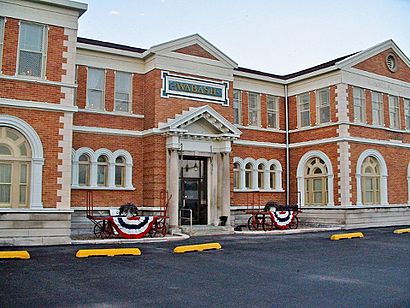Decatur station (Illinois) facts for kids
Quick facts for kids
Decatur, IL
|
|||||||||||||||||
|---|---|---|---|---|---|---|---|---|---|---|---|---|---|---|---|---|---|
| Former Wabash Railroad and Amtrak passenger rail station | |||||||||||||||||

Decatur station in August 2006.
|
|||||||||||||||||
| Location | 780 East Cerro Gordo Street, Decatur, Illinois 62523 | ||||||||||||||||
| History | |||||||||||||||||
| Opened | July 1, 1981 (Amtrak) | ||||||||||||||||
| Closed | May 1, 1971 (Norfolk and Western) July 10, 1983 (Amtrak) |
||||||||||||||||
| Former services | |||||||||||||||||
|
|||||||||||||||||
|
Wabash Railroad Station and Railway Express Agency
|
|||||||||||||||||
| Location | 780 E. Cerro Gordo St., Decatur, Illinois | ||||||||||||||||
| Area | less than one acre | ||||||||||||||||
| Built | 1901 | ||||||||||||||||
| Built by | Menke, Edward H. | ||||||||||||||||
| Architect | Link, Theodore | ||||||||||||||||
| Architectural style | Classical Revival | ||||||||||||||||
| NRHP reference No. | 94000029 | ||||||||||||||||
| Added to NRHP | February 4, 1994 | ||||||||||||||||
The Decatur station is a historic train station in Decatur, Illinois. It's also known as the Wabash Railroad Station and Railway Express Agency. Built in 1901, this station was a very important stop for the Wabash Railroad. A famous architect named Theodore Link designed it in a style called Classical Revival. Train service stopped here in the 1980s. Today, it's recognized as a special historic place on the National Register of Historic Places.
Contents
History of the Decatur Train Station
Early Railroad Days in Decatur
Trains first came to Decatur in 1854. The Great Western Railroad built a track through the city. Decatur built its first train station, called Union Station, in 1856. This station served the new train line.
Building the New Wabash Station
By 1901, the Great Western Railroad had become part of the Wabash Railroad. The old Union Station was getting very old and worn out. So, the Wabash Railroad decided to build a brand new station. This new station, which is the one we see today, cost about $70,000 to build. A railroad manager thought it was one of the most impressive buildings on the entire train line.
A Busy Hub for Travel and Goods
The Wabash Railroad was the only major east-west train line going through Decatur. Both passenger trains and freight trains were very busy here. At its busiest in 1907, about 72 passenger trains arrived and left Decatur every day. Goods worth hundreds of thousands of dollars were shipped through the station each year. The railroad was also the biggest employer in Decatur. Many people in the city worked for the railroad.
The End of Passenger Service
After the 1920s, fewer people started taking passenger trains. Even though train travel became less popular, the railroad continued to serve Decatur. The Wabash Railroad later joined with the Norfolk & Western. In 1971, a new national train service called Amtrak was created. Amtrak tried to bring passenger service back to Decatur in 1981 with a train called the Illini. However, this service only lasted for two years. The Decatur station closed for good in 1983.
A Historic Landmark
On February 4, 1994, the Decatur station was added to the National Register of Historic Places. This means it's recognized as an important historic building. It is the only old train station left in Decatur today.
Architecture of the Station
Classical Revival Style
A famous architect from St. Louis named Theodore Link designed the Decatur station. He used a style called Classical Revival. This style often uses ideas from ancient Greek and Roman buildings.
Two Main Buildings
The station actually has two separate parts. There's the main station building and another building for the Railway Express Agency. Both buildings are two stories tall. They were built using yellow brick and light-colored limestone. They also have special decorations made from terra cotta and sandstone.
Special Design Details
The main entrance and the east entrance of the station have a special triangular top part called a pediment. This pediment has fancy decorations. On the sides of the entrances, there are tall, flat columns called pilasters. These pilasters are in the Ionic style, which means they have scroll-like designs at the top. The windows on the first floor have arched frames made of sandstone. There are also two decorative bands, called belt courses, that go around the building above and below the second floor. The corners of the building have special stone blocks called quoins.



